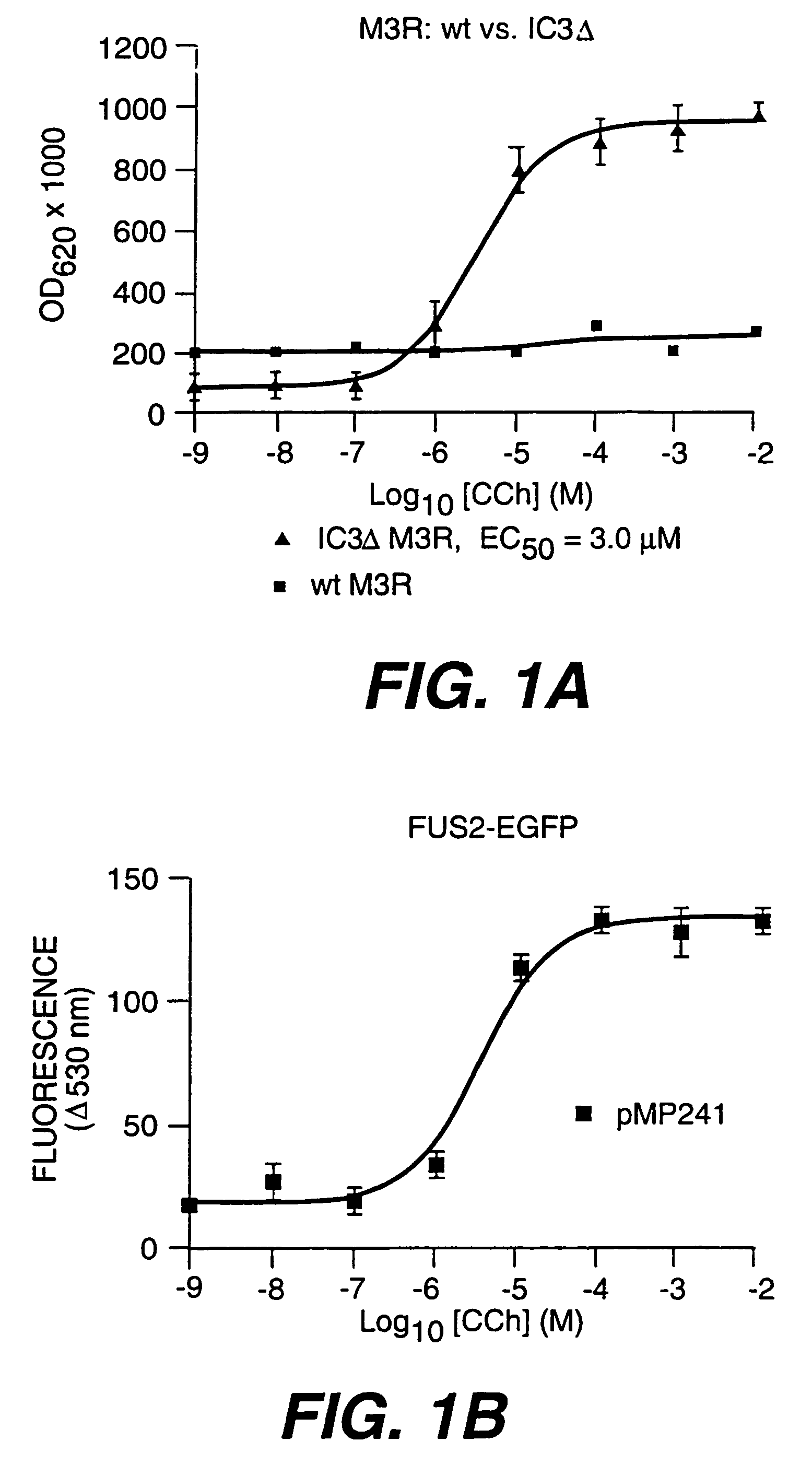Method for improving the function of heterologous G protein-coupled receptors
a technology of g protein and receptor, which is applied in the field of mutant g protein-coupled receptors, can solve the problems of significantly reducing the utility of genetically modified microorganisms in screening assays, inappropriate localization and/or desensitization, and poor growth assay performance of microorganisms transformed with wild-type receptors, so as to reduce the number of false negatives, improve the sensitivity of bioassays, and prevent or reduce cell growth arres
- Summary
- Abstract
- Description
- Claims
- Application Information
AI Technical Summary
Benefits of technology
Problems solved by technology
Method used
Image
Examples
example 1
Functional Expression of a Mutated Rat M3 Muscarinic Acetylcholine Receptor (MAR) in Yeast
[0025]The third intracellular loops of GPCRs are thought to interact with and participate in the activation of G proteins upon agonist binding. J. Wess (1997). Mutations in IC3 of the yeast mating pheromone receptors, Ste2 and Ste3 have profound effects on coupling the G proteins. C. Boone et al. (1993) and C. Clark et al. (1994). Importantly, deletion of portion of the IC3 of mammalian MARs, in particular the rat M3 MAR, is correlated with improved functional expression in mammalian cells with retention of full ability to couple to the heterotrimeric G protein, Gq (Gαβγ). The mutated M3 MAR retains all external loops. Transmembrane domains (TMDs) and internal domains other than the IC3 are unchanged. The IC3, found between 5th and 6th membrane spanning helices, was the only domain modified. The bulk of this domain, 196 amino acids in the center of the IC3 (Ala273-Lys469), were deleted, leaving...
example 2
Functional Expression of a Mutated D. melanogaster Muscarinic Acetylcholine Receptor in Yeast
[0032]Agonist of the G protein-coupled insect muscarinic acetylcholine receptors (MARs) possess substantial insecticidal and miticidal activity. M. R. Dick et al. (1997). These observations suggest that development of a yeast-based high throughput screen (HTS) for agonists active at insect MARs may be useful in identifying lead compounds that might be developed into insecticides with novel mode of action. Preliminary experiments indicate that the wild type D. melanogaster MAR (DMAR), an insect G protein-coupled receptors (GPCRs), is non-functional in yeast. Thus, an effort to develop a method for improving the function of the DMAR in yeast was mounted, via replacement of the DMAR IC3 with the functional IC3 from the M3 MAR IC3Δ.
[0033]In insect cells, the DMAR interacts with the heterotrimeric Gq protein leading to an increase in intracellular calcium in response to muscarinic agonists. One p...
example 3
Functional Expression of a Mutated Rat Cholecystokinin CCKB Receptor in Yeast
[0037]As shown in Examples 1 and 2, deletion of portion of the IC3 of mammalian MARs, in particular the rat M3 MAR, is correlated with improved functional expression in mammalian and yeast cells with retention of full ability to couple to the heterotrimeric G protein. In order to test the possibility that this IC3Δ mutation would also improve functional expression of other GPCRs in yeast, the DNA sequences encoding the rat wild type and IC3Δ cholecystokinin CCKB receptor were amplified by PCR and cloned into proximity to the glycerol-phosphate dehydrogenase promoter in yeast expression plasmid, p426GPD, by standard methods. The wild type CCKBR was amplified by PCR using oligonucleotides (ACTTAGATCAAAAAATGGAGCGCTCAAGCTGAACCG) (SEQ ID NO: 11) and (TCCCGTCGACTCAGCCAGGCCCCAGTGTGCTG) (SEQ ID NO: 12). The IC3Δ cholecystokinin CCKB receptor was prepared by fusing two overlapping fragments. Fragment 1 contained ami...
PUM
| Property | Measurement | Unit |
|---|---|---|
| Length | aaaaa | aaaaa |
| Length | aaaaa | aaaaa |
| Cell growth | aaaaa | aaaaa |
Abstract
Description
Claims
Application Information
 Login to View More
Login to View More - R&D
- Intellectual Property
- Life Sciences
- Materials
- Tech Scout
- Unparalleled Data Quality
- Higher Quality Content
- 60% Fewer Hallucinations
Browse by: Latest US Patents, China's latest patents, Technical Efficacy Thesaurus, Application Domain, Technology Topic, Popular Technical Reports.
© 2025 PatSnap. All rights reserved.Legal|Privacy policy|Modern Slavery Act Transparency Statement|Sitemap|About US| Contact US: help@patsnap.com



